
Dark Energy Project sees a Ray of Hope
Runaround Veteran Preps Next Generation
Dark Energy Project sees a Ray of Hope
Research Council Recommends JDEM Get Top NASA Priority
Late on Wednesday, Sept. 5, East Coast time, after months of suspense, the word was out. The report of the National Research Council’s Beyond Einstein Program Assessment Committee (BEPAC) was finally posted on the web. It recommended that “NASA and DOE should proceed immediately with a competition to select a Joint Dark Energy Mission (JDEM) for a 2009 new start.”
After a year spent assessing NASA’s five Beyond Einstein cosmology missions — to detect gravitational waves, build a powerful x-ray telescope, investigate cosmic inflation, find black holes, and study the nature of dark energy — the choice of JDEM was welcome news indeed for Berkeley Lab, UC Berkeley, and the dozens of collaborating institutions on the SuperNova/Acceleration Probe, or SNAP.
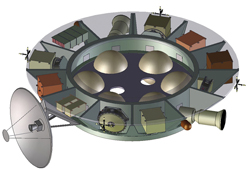 SNAP spacecraft
SNAP spacecraft
“NASA and DOE joined forces on the Joint Dark Energy Mission four years ago, including support for Berkeley Lab’s approach to the mission, SNAP,” said Laboratory Director Steve Chu. “We look forward to the agencies aggressively moving forward upon receiving the NRC Committee Report.”
“Each of the highly ranked Beyond Einstein projects will contribute greatly to our understanding of the universe,” said Saul Perlmutter of the Physics Division, who leads SNAP with co-principal investigator Michael Levi. “Yet few questions are more fundamental or pressing than the mysterious nature of dark energy, which accounts for some three-quarters of the density of our universe — but about which we know almost nothing.”
The day after the BEPAC report was released, astrophysicist Joel Primack of UC Santa Cruz, one of the 22 members of the BEPAC committee, addressed a crowd in the Building 50 auditorium to explain the findings and offer his personal interpretation of what they implied.
“There’s no other choice we could have made besides JDEM,” Primack said, emphasizing that the decision was based on both scientific and practical considerations. How well did each mission fit the Beyond Einstein goals? What contributions was it likely to produce beyond those goals? How proven was the technology, and how well had the costs been estimated?
The dark energy mission won on all counts. For example, said Primack, “Broader science is a reason to choose JDEM even if it didn’t achieve its Beyond Einstein goals. So much extremely valuable astrophysical data — this is what persuaded us.”
A near co-winner was LISA, the proposed Laser Interferometer Space Antenna to detect gravity waves, called “an extraordinarily original and technically bold mission concept that will open up an entirely new way of observing the universe.” But BEPAC recommended that LISA await a test of its key technologies scheduled by NASA’s partner, the European Space Agency.
One additional factor influenced the committee’s choice, Primack admitted with a smile. “We counted the Nobel Prizes these missions could earn” — including “at least one or two for JDEM.”
SNAP is JDEM’s forerunner and one of three contending proposals, the others being ADEPT, led by Charles Bennett of Johns Hopkins University, and Destiny, led by Tod Lauer of the National Optical Astronomy Observatory. SNAP was begun in 1999 by members of the Berkeley-Lab-based Supernova Cosmology Project, soon after they and the rival High-Z Supernova Search Team announced their discovery of the accelerating expansion of the universe. Dark energy was the name given to whatever was propelling the accelerated expansion.
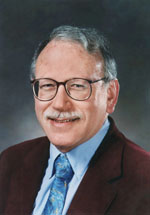 Primack
Primack
From the beginning SNAP incorporated two complementary techniques to investigate the expansion history of the universe, the key to dark energy: recording the distance and redshift of some 2,000 Type Ia supernovae a year, and measuring the distribution of matter in the universe as revealed by “weak gravitational lensing.”
SNAP has been vigorously supported by the Office of Science since it was first proposed and supported by NASA since the space agency joined DOE to open a competitive mission in 2003. But the future of JDEM and other science programs was immediately called into doubt early in 2004, when NASA was redirected to send astronauts to the Moon and Mars.
Budget and technological issues dictated that only one of the five Beyond Einstein missions already on the boards could be initiated — and not until fiscal year 2009. In August, 2006, under pressure from Congress, NASA and DOE requested that the NRC assess the program and recommend which mission should go first. JDEM was the choice.
Next, says SNAP’s co-PI Levi, “we expect the JDEM competition to appear in the administration’s FY09 budget request next February.” With the contest joined, NASA and DOE must jointly choose among the JDEM proposals.
JDEM isn’t out of the woods, as Primack emphasized. “The entire astrophysics community has to get behind JDEM,” he said, “even those whose projects did not fare well in the BEPAC report. And physicists have to make it known that dark energy is a fundamental problem of particle physics, not just of astrophysics.”
High-energy physicists like Pier Oddone, former Deputy Director of Berkeley Lab and now Director of Fermilab, a partner in the SNAP collaboration, underscore Primack’s point. “For many years, the Department of Energy has supported research at the interface of particle physics and astrophysics here at Fermilab as well as at other institutions,” he wrote recently. “The most dramatic discovery of the last decades has been the discovery of dark energy by two teams, one of them supported by the Department of Energy.... The partnership of DOE and NASA provides a great opportunity to advance the study of this profound mystery....”
Assuming JDEM survives, how can SNAP win? Primack emphasized the practical: “Keep the costs down and stress the broader science. SNAP will be an incredibly valuable spacecraft well beyond its primary mission. Think beyond Beyond Einstein.”
SNAP’s lead institutions are Berkeley Lab and the UC Berkeley Space Sciences Laboratory. The SNAP collaboration includes dozens of NASA and DOE facilities, industrial partners, and research centers and universities in the U.S. and Europe.
Runaround Veteran Preps Next Generation Of Race Sponsors to Ensure Continued Success
Life scientist Steve Derenzo, known by many as “Mr. Runaround,” was there for the debut of the annual Lab race back in 1978. Under the tutelage of then-employee Harvey Levy, Derenzo learned the ins and outs of organizing the event. With this wisdom under his belt, Derenzo took over the reins in 1980 and has been the driving force behind the Runaround ever since (with help from numerous volunteers over the years, of course).
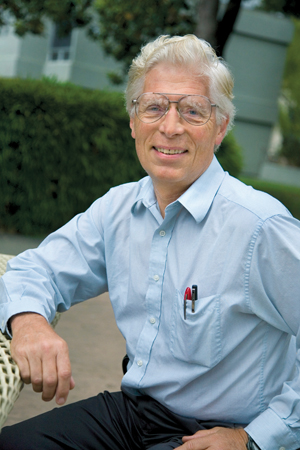 Derenzo
Derenzo
“This has been my contribution to both the running community and the Lab community,” says Derenzo of his commitment to the annual foot and bicycle “fun run” race over the last 29 years. “I take pleasure in doing things well, and this was a project in which we sought continual improvement.”
But now, with the 30th Runaround approaching on Friday, Oct. 19, Derenzo felt it was time for the next generation of employees to step in, ensuring that the race will continue for another 30 years. The Lab’s Employee Activities Association (EAA) will take over responsibility for the event starting this year.
“Hosting the race — which is most likely the Lab’s largest event — requires a special dedication,” explains Derenzo. “I don’t want it to falter.”
Derenzo is not totally out of the picture, however. He will continue to start the race, compile the results and maintain the Runaround’s website (cfi.lbl.gov/~derenzo/runaround/). And he will also share his expertise with EAA organizers, to ensure the event continues to go smoothly.
“I always worry that something will go wrong,” says Derenzo. “But every year, it has gone off without a hitch.”
Well, there was the time that German Chancellor Helmut Kohl was visiting the Lab on the same day as the 1991 Runaround, but that proved to be only a minor challenge.
“Up to that point, we used a calcium carbide cannon, which combines oxygen and acetylene to create an explosive sound, to start the race,” Derenzo recalls. “But the chancellor’s secret service kindly requested that we refrain from using it.”
Derenzo encourages all employees to participate in the Runaround, either as a walker or a runner. “It’s a great way to meet other staff members and to see the layout of the entire Lab,” he says.
While space does not allow listing their names here, Derenzo would like to thank all the volunteers who have donated their time over the years. “Their participation is crucial,” he says. “Without them, the Runaround would not happen.”
War Duty Gives Site Access Manager Daily Dose of Wisdom
When Sam Houston first came to Berkeley Lab to interview for a part-time position issuing ID badges, his orientation included a tour of the Laboratory’s hilly site. Struck by the quirkiness of the cobbled-together collection of aging buildings tucked alongside world-class scientific facilities, it dawned on Houston that until he answered that job posting he hadn’t even been aware of the Lab’s existence up on the hill. That was about to change.
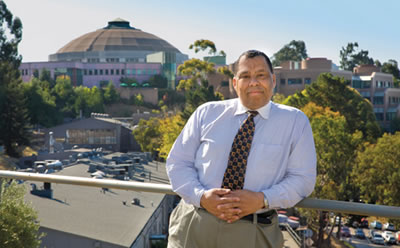 Houston
Houston
After landing the job, he soon found himself deposited squarely in the vintage and cramped trailer known as the Building 65A Badge Office, perched high above the venerable 88-inch cyclotron. The location might have caused a less-seasoned worker chagrin, but the soft-spoken, amiable Houston was just fine with his trailer lodging. After all, he was only taking the job to augment his private consulting business, and he didn’t expect to stay more than a year.
That was four years ago, and Houston is now solidly ensconced as the Lab’s new Site Access Manager, a responsibility that includes managing the comings and goings of the thousands of employees, guests and students who visit the Lab every day, as well as serving on the Lab’s Emergency Operations Team and performing numerous security duties.
That “year” turned out to be mighty long.
Like others who’ve come to work here, Houston found the Lab got under his skin, making it harder and harder for him to leave. When the opportunity arose for the site manager position, he began to take the idea of a career here even more seriously. “I think what I like most is being part of such a rich institution,” he says. “I’m walking on the hill next to Nobel Prize winners like George Smoot, people making important contributions to the world, and in a small way I’m making my own contribution to that.” Dan Lunsford, Houston’s supervisor, has given him opportunities to grow in his job, making it particularly rewarding, Houston says.
A transplanted New Yorker, Houston lives in San Francisco now. One of his favorite pastimes is walking the neighborhoods there, taking in the richness and diversity of the City. “It’s not New York,” he says, “but it’s a great city, with its own spirit.” Still, he says, in his heart he’ll always be a New Yorker. “You just can’t take it out of me,” he laughs, “I’d move back there in a minute if the Lab ever relocated there.”
Spend a little time with Sam Houston, and you come away impressed by his genuine affection for people, as well as his resilience and worldly outlook on life. Much of that is owed to his experience as a Navy corpsman assigned to the Marines during the Vietnam War. In the corner of his office wall, tucked in among other memorabilia, is a small unassuming frame containing 3 Purple Hearts, the military decoration awarded to soldiers who have been wounded or killed in battle.
Houston earned his Purple Hearts during two tours of duty, receiving wounds while dragging injured marines to safety. He says he keeps the medals on display not for others to see, but because they are a daily reminder of who he is — the things he’s seen, and especially the comrades he served with in Vietnam who he remains closely connected to. They’re part of his humanity, and he doesn’t want to forget any of them, or the experience that banded them together. “It’s a powerful brotherhood,” Houston says, “even 30 years later.”
It may be a world away from his scenic hillside perch above Berkeley these days, but like New York still close to his heart.
(Postscript: As of press time, the Lab was still not considering a relocation to New York.)
Cake, Cookies, and Two Years of Safe Construction
Berkeley Lab celebrated two years of almost injury-free construction work at a Facilities Division-hosted event in Perseverance Hall on Aug. 31.
This two-year run of construction work with only one injury wouldn’t be possible without contributions from many different groups. The Lab’s construction projects are a partnership between the Facilities Division, customers in research and operations, the EH&S Division, the Procurement and Property Management Department, and the Lab’s construction subcontractors. Together, these groups undertake construction projects that meet their customers’ needs, and they deliver this work on time, within budget and on schedule, and most importantly, safely.
And together, these groups celebrated a milestone achieved in mid-August, when the Lab completed 24 months of construction work, including more than 335,000 work hours (the equivalent of 80 full-time employees), with only one recordable injury. This significant accomplishment is far better than the national average. While the national construction industry’s safety record has improved over the past decade, the average Total Recordable Case Rate (TRC) for all U.S. construction work for 2005 was 6.1, according the Bureau of Labor Statistics. Berkeley Lab’s TRC for the previous 24 months was one.
“This achievement is based on the collective effort of everyone involved,” says Richard Stanton, chief project manager of the Facilities Division’s Planning, Design, and Construction Department. “We have put a lot of effort and energy into making sure that construction projects are conducted safely.”
Jean Myers, a construction safety engineer in the EH&S Division who reviews all construction maintenance contracts to ensure that contractors adhere to applicable safety regulations before they commence work, adds, “Building strong relationships with the contractors is a big part of our safety success. We make sure they know before they start working at the Lab that safety is a paramount concern of ours.”
To recognize their significant contributions to the Lab’s success, representatives from many of the Lab’s construction subcontractors were invited to the celebration.
Berkeley Lab View
Published once a month by the Communications Department for the employees and retirees of Berkeley Lab.
Reid Edwards, Public Affairs Department head
Ron Kolb, Communications Department head
EDITOR
Pamela Patterson, 486-4045, pjpatterson@lbl.gov
Associate editor
Lyn Hunter, 486-4698, lhunter@lbl.gov
STAFF WRITERS
Dan Krotz, 486-4019
Paul Preuss, 486-6249
Lynn Yarris, 486-5375
CONTRIBUTING WRITERS
Ucilia Wang, 495-2402
Allan Chen, 486-4210
David Gilbert, (925) 296-5643
DESIGN
Caitlin Youngquist, 486-4020
Creative Services Office
Berkeley Lab
Communications Department
MS 65, One Cyclotron Road, Berkeley CA 94720
(510) 486-5771
Fax: (510) 486-6641
Berkeley Lab is managed by the University of California for the U.S. Department of Energy.
Online Version
The full text and photographs of each edition of The View, as well as the Currents archive going back to 1994, are published online on the Berkeley Lab website under “Publications” in the A-Z Index. The site allows users to do searches of past articles.
Flea Market is now online at www.lbl.gov/fleamarket
The Little Engine That Could
Light Powers world’s smallest Piston
Tomorrow’s nano-sized machines may share something in common with the workhorses of yesteryear. A team of Berkeley Lab and UC Berkeley scientists have developed a four-legged molecule that moves up and down like a tiny piston, powered only by a beam of light.
Although still very early in the investigational stages, these molecules hold promise for a number of applications in which reversible action at the nano-scale is required. Several of these molecule could be pieced together to make microscopic machines capable of crawling across a surface. They could also be used to make a so-called smart surface that changes properties when exposed to a stimulus such as light. Or they could form electrical switches that turn on and off in response to light.
 Crommie, left, and Comstock
Crommie, left, and Comstock
Led by Michael Crommie, a physicist in Berkeley Lab’s Materials Sciences Division and UC Berkeley’s Department of Physics, the scientists attached four “legs” to an azobenzene molecule, and then placed thousands of these legged structures onto a sheet of gold. When they exposed the sheet to ultraviolet light, some of the molecules changed shape and lifted themselves above the surface. A second beam of light reversed this action, causing the molecules to plop back down.
The team observed this up-and-down motion using scanning tunneling microscopy (STM), a technology capable of imaging single atoms. It allowed the scientists to watch individual molecules rise and fall like a nano-scale game of whack-a-mole.
Scientists have long studied how molecules such as azobenzene change shape in the presence of light. But most of these analyses have focused on billions of molecules at once using a technique that only reveals how large groups of molecules contort themselves. Scientists have also used STM to watch single molecules change shape, but only after prodding the molecule with the atom-sized tip of the STM instrument.
In this work, however, the Berkeley team used a remote source such as light to reversibly change the structure of a molecule, and observe this change at the single-molecule scale.
The team began with an azobenzene molecule, which is known to change shape when exposed to light. However, the light-induced, shape-changing characteristic of azobenzene is dampened when the molecule is attached to a surface. For reasons not entirely understood, the interaction between azobenzene and the surface suppresses the molecule’s ability to rearrange itself when it absorbs a photon.
To reduce the coupling between azobenzene and the surface, chemists from the Berkeley Lab research groups of Jean Frechet and Dirk Trauner attached legs to the molecule, with each leg composed of a four-carbon group called tert-butyl. These legs raise the azobenzene molecule slightly above the gold surface, which to some degree disentangles it from the surface’s influence.
“The legs free the molecule from being interfered with by the metallic surface,” says Matthew Comstock of Berkeley Lab’s Materials Sciences Division and a graduate student in UC Berkeley’s Department of Physics.
Next came the test. When placed on the gold surface and illuminated by ultraviolet light, azobenzene molecules with zero and two legs did not change shape, but molecules with four legs did. Later, when the four-legged molecules were hit with another beam of light, they folded back to their original shape.
Comstock is the lead author of a paper that outlines this research which is published in the July 20 issue of Physical Review Letters. Other Berkeley Lab and UC Berkeley scientists who contributed to this research include Jongweon Cho, Jessica Harvey, Armen Kirakosian, Frank Lauterwasser, Niv Levy, Steven Louie, and David Strubbe.
Sequences Unchanged for 80 Million Years — but Indispensable?
The more genomes we sequence, the more conserved sequences we find, lengths of DNA in which the order of base pairs is similar among species. Humans share conserved sequences with chickens, fish, fruit flies, sea squirts, and many other species.
Scientists assume they know why: some sequences persist because they are indispensable. Changes in them would kill the organism or make reproduction impossible, so are weeded out by evolution.
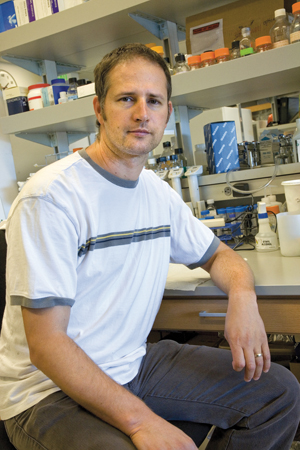 Ahituv
Ahituv
In the case of genes, a change that gets one or two amino acids out of place in a vital protein can be fatal. Many conserved sequences are not genes, however, yet these too are assumed to be indispensable, because they are thought to regulate the expression of critical genes.
Recently “ultraconserved“ sequences were discovered in mice, rats, and humans — nearly 500 such sequences of at least 200 base pairs, all 100 percent identical among the three species, whose common ancestor lived more than 80 million years ago.
Nadav Ahituv, Len Pennacchio, Edward Rubin and their colleagues in Berkeley Lab’s Genomics Division and DOE’s Joint Genome Institute tested the hypothesis that noncoding ultraconserved sequences are indispensable by engineering four lines of “knockout” mice, each lacking an ultraconserved element thought to regulate the expression of a critical gene.
They expected their knockout mice to die or be unable to produce viable offspring. Instead, the mice showed virtually no ill effects.
“For us, this was a really surprising result,” says Ahituv, who led the experiment. “Our knockout mice were not only viable and fertile but showed no critical abnormalities.”
“While I don’t think we can conclude that the mice we created with the ultraconserved elements deleted are normal,” says Rubin, who heads JGI and the Genomics Division and directed the study, “we can confidently conclude that the presence of the ultraconserved elements are not required for the viability of the organism.”
For example, ultraconserved element 467 (uc467) is thought to be an enhancer for ARX, a gene that, when defective in mice, disturbs male sexual development and causes lethal brain abnormalities, and in humans causes a wide range of neurological and sexual-development disorders.
“Knocking out the gene itself leads to lethality or sexual abnormalities in mice,“ says Ahituv. “We expected that mice lacking the ultraconserved sequence thought to regulate this gene would show a similar result.”
But mice lacking uc467, like the other lines of knockout mice, were healthy and produced normal litters. Clinical assays showed no signs of abnormality in the knockout mice and no significant differences compared to wild-type controls. If evolution selects against changes in highly conserved elements, why don’t problems show up when such an element is missing?
“Evolution and natural selection do not happen overnight,” says Pennacchio, a primary author of the study. “Deletion of these elements likely has relatively mild effects on fitness, that are gradually selected against over time.”
“It may be that we saw no deleterious effects in the knockouts because nature provides a backup for these ultraconserved elements,” Ahituv adds, “though this still does not explain why they are so ultimately conserved.”
The discovery is a major challenge to understanding how highly conserved elements of the genome persist and what their functions are, says Ahituv. He and his colleagues are pursuing research aimed at answering these compelling new questions.
What goes on…? A Random Look Inside the Not-So-Familiar Buildings of Berkeley Lab
Berkeley Lab is comprised of 160 buildings across its 200 hillside acres. They include everything from the “beacon” on the hill, the Advanced Light Source, to modest trailers tucked into nooks and crannies. Some dominate the landscape (Molecular Foundry, Building 90, Building 50), while others blend into the terrain. And there are some that employees come across every day and wonder, “What in the world goes on in there?”
This is a photo essay on a few of those not-so-familiar structures. This tiny sampling, captured by award-winning Lab photographer Roy Kaltschmidt, is an indication of just how diverse and complex this community is. So next time you drive past Buildings 55, 64, 85, 5, 58 and 63, you’ll have a greater appreciation for the work that goes on here. And that this just scratches the surface.
— Ron Kolb
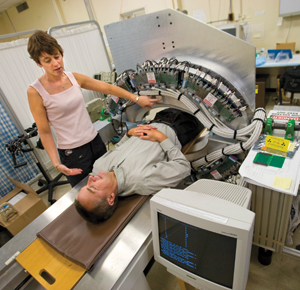
New Hope for Prostate Cancer Patients
A new first-of-its-kind machine is being tested where it was assembled in Building 55 — the Center for Functional Imaging — that could make a major impact on the diagnosis and treatment of prostate cancer. Research scientist Jenny Huber is shown here running project scientist Brian Reutter through a Prostate PET (positron emission tomography) camera. With scanners and detectors in a torso shape around the body — as opposed to the bulky mechanics of a traditional PET scanner — scientists can more precisely guide the image to perform a biopsy or administer treatment to the affected area. It will also track post-treatment analysis faster than ever before. This three-year project that began in April is funded by the Departments of Energy and Defense.
Don’t Call Them Dummies
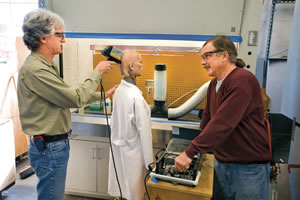
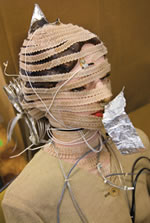
They are now in storage in Building 63, but don’t let their laconic expressions fool you. These mannequins are smart, thanks to surgery performed by Environmental Energy Technologies engineers. “Paula” may make history for her contributions to a revolutionary new fume hood. And her sister’s mummy-style garments (right) could lead to much healthier office environments in the future. Geoffrey Bell (above left), senior energy management engineer, takes a reading of emissions at Paula’s head while senior scientific energy associate Doug Sullivan controls the instrumentation. After over three years of testing, the energy-efficient fume hoods were licensed to Esco Global Technologies and will make their commercial debut later this year. Next step: find a less polluting test gas that might make Paula obsolete (Bell calls it “human-as-mannequin” testing). The other mannequin might return to Building 70, wrapped in heating tape, to undergo more task ventilation tests.
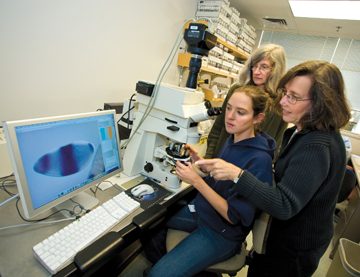
Filling Out the Fly Blueprint
With the successful sequencing of the human genome and a variety of plant and animal species, the world has virtually forgotten the fruit fly — Drosophila melanogaster—the most studied organism in biological research, especially in genetics and developmental biology. They haven’t forgotten this in Building 64, where work continues on fly embryos in the tireless search for transcription factors that dictate the organism’s development. With more than 60 percent of the fly’s genes shared with humans, insights gained about behavior, development and disease systems in the fly could translate someday into real-world applications — some consider it the Rosetta Stone for human genetics. Since 2000, when the fly’s genome was first articulated, genetic pioneers like Susan Celniker (front) have worked with NIH grants to add to the growing database of gene expression. Here, student assistant Caitlin Barale tracks an embryo on a monitor attached to a digital electron microscope, with research scientist Ann Hammonds (back) looking on.
Accelerator Legacy Alive and Well
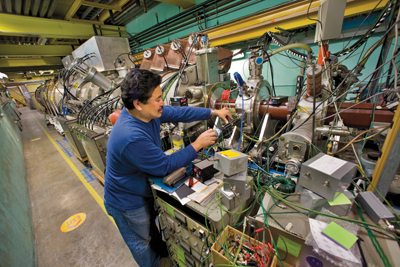
The front-end system for the Spallation Neutron Source exited Berkeley Lab for installation in Oak Ridge, TN five years ago, and with it went the Lab’s last large-scale accelerator apparatus construction project. But, like a venerable and wise ancestor, a 20-meter-long mass of steel, magnets, wiring and electronics continues its low-profile work in Building 58. A 2-million-volt fusion testbed called the High Current Transport Experiment, or HCX, grinds on under the watchful eyes of a team that includes mechanical technician Tak Katayanagi (left). He has been with this diagnostic tool since it was built over 20 years ago, and in that time he’s seen experiments on aperture limits, electron and gas effects, halo formation, and steering, critical information that has contributed to the world’s top accelerators. Determining optimum beam size and the best means of preserving beam quality during transport are also crucial for designing future experiments and heavy-ion fusion drivers. The HCX consists of an ion injector plus 10 electrostatic and four magnetic quadrupole magnets.
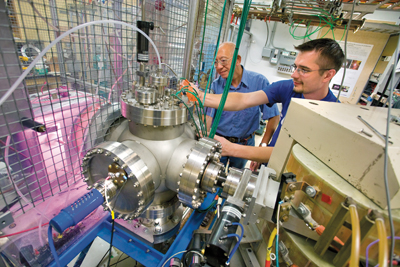
Hot Time in the Old Town
They call the single-digit buildings at Berkeley Lab “Old Town,” and for good reason. They were the first to be built on the hill when the Lab moved up from UC Berkeley. Today they house a variety of administrative and research offices, plus experimental work that harkens back to the old days — plasma physics and neutron sources. A pink light flashes in an interior room of Building 5, as physicist Joe Kwan (back) and visiting scholar Hannes Vainionpaa of Finland make adjustments on a neutron beam test bed. The process “bakes” the ion source to clean up the beam, which will eventually make its way to the Princeton Plasma Physics Laboratory. Berkeley Lab, one of the world’s premier repositories of ion source expertise, has several such test stands to maximize beam quality, current and species for users elsewhere.
No Glamour, But Without Them There’s No Lab
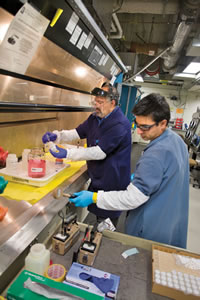
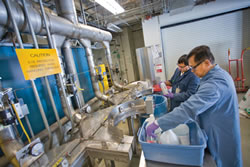
Far removed from the glamour of science — but no less important — is the industrial-gray building and staging area called the Hazardous Waste Handling Facility (Building 85). Thank the people inside for making it possible for researchers to continue to use toxic and radio-active tools in their work. It is their job to get rid of the waste generated across the Lab, and in a safe and timely manner as required by law. Mixed Waste Team Lead Steve Bakhtiar (lower left) is shown neutralizing an acid-based solution so that it will qualify for disposal, while radiation safety technician Anthony Fernandez makes sure no radioactive elements escape the fume hood during the procedure. The last step before shipping 55-gallon drums to disposal sites for incineration is packing the waste in layers, surrounded by vermiculite, an absorbent material similar to kitty litter. Hazardous waste technician Javier Garcia (back right) places bottles of inorganic waste — in this case, ammonium hydroxide — into the drum while colleague Ricky DeGuzman weighs and characterizes the contents for entry into a database.
Berkeley Lab Science Roundup
Record-Setting Performance at TEAM
 TEAM microscope
TEAM microscope
Tests performed by Transmission Electron Aberration-corrected Microscope (TEAM) project members achieved a record resolution of 0.5 Angstroms (Å), which is about half the diameter of a hydrogen atom. The tests were carried out on TEAM 0.5, the first of two separate microscopes — TEAM 1.0 will be the second — that will transition Berkeley Lab’s National Center for Electron Microscopy (NCEM) into a new era of nanocharacterization research.
“The extraordinary vision of the TEAM microscopes will bring us one step closer to meeting one of the great scientific challenges in electron microscopy – obtaining 3-dimensional atomic resolution images that allow us to see every atom in an individual nanoparticle,” said Uli Dahmen, director of NCEM.
While the record-setting 0.5 Å resolution was the microscope’s design goal, it was achieved ahead of schedule, an exceptionally good start in the view of TEAM project manager Peter Denes of the Engineering Division.
“Our early success is a validation of the investment by the Department of Energy (DOE) in the development of world-class scientific instrumentation, and a good omen for other major projects in electron microscopy.”
TEAM microscopes are designed to provide real-time sub-angstrom resolutions through aberration-correcting in the electric and magnetic fields that constitute electron optics. TEAM 0.5 will provide corrections for spherical aberrations (blurring) and TEAM 1.0 will correct for spherical and chromatic (rainbow distortions) aberrations. These aberrations have been the prime limiting factors in electron microscopy resolution.
The TEAM project is a DOE collaboration led by Berkeley Lab that includes researchers at Argonne, Brookhaven and Oak Ridge National Laboratories, plus the University of Illinois at Urbana-Champaign. The project also features commercial partners such as FEI Corporation of Hillsboro, OR, and the electron optics manufacturer CEOS, of Heidelberg, Germany. TEAM 0.5 is currently undergoing acceptance tests and will be installed later this year in the NCEM silo that formerly housed the High Voltage Electron Microscope. It is scheduled to open as a national user facility in 2008.
Pinning Down the Spin
 Copper surface with cobalt islands
Copper surface with cobalt islands
A collaboration led by Michael Crommie, a physicist with the Materials Sciences Division, has obtained the first measurements of the quantum property known as “atomic spin.” While researchers previously have been able to deduce the spin polarization of an atom in a surface or thin film where the atoms are packed together and the spins are in an orderly arrangement, until now no one has been able to directly measure the polarization of an individual atom that sits on top of a surface and is not incorporated into it. Such atoms are called “adatoms” and being able to measure and control their spin could well be crucial to the development of spintronics — electronic technology that harnesses not just charge (like today’s electronics) but also spin.
“From a technical point of view, our results demonstrate a new ability to engineer, fabricate and measure spin-polarized nanostructures at the single atom level,” said Crommie. “Now that we can see an atom’s spin, we can start incorporating this property into other structures.”
Crommie, working with UC Berkeley postdoctoral fellow Yossi Yayon and graduate student Victor W. Brar, created islands of cobalt atoms on a cold copper substrate (4.8 Kelvin) and sprinkled these islands with atoms of either iron or chromium. Employing low-temperature, spin-polarized scanning tunneling spectroscopy, the researchers were able to determine the spin of isolated adatoms atop the cobalt nanoislands.
“These magnetic islands are teeny tiny nanomagnets, but from the single-atom perspective they are just large fixed ferromagnets, like a refrigerator magnet,” Crommie said. “We took individual atoms and coupled them to these large magnets so we could fix the direction of the spin of an atom and it would stay put.”
Not So Friendly Skies for Air Travel

Airline passengers and crews often complain about headaches, dry eyes and chaffed lips, stuffy noses, etc., after being cooped up in planes for several hours. A new study that included William Nazaroff, of the Environmental Energy Technologies Division, has implicated as the cause of these symptoms the interaction of elevated levels of ozone — typical of aircraft in flight — with the oils on skin, hair and clothing. In simulated flights lasting four hours, Nazaroff and his collaborators placed two groups of 16 volunteers in a mockup of an airline cabin and then exposed them to varying levels of ozone and air flow, including levels typically experienced in real flights. Consistently, ozone in the cabin increased production of identifiable chemical byproducts including nonanal and decanal, a pair of aldehyde compounds associated with headaches, nasal irritation and other common air traveler complaints.
According to Nazaroff and co-authors of a paper published by the American Chemical Society, most of these byproducts were produced when the ozone interacted with squalene, oleic acid and other compounds in natural skin oils. Since humans can’t stop these natural oil secretions, the paper’s authors suggest that ozone-destroying catalysts could be installed in airplane ventilation systems to help remove most of the ozone from incoming air.
At cruising altitude, the atmosphere outside of aircraft contains very high ozone levels, frequently topping more than 500 parts per billion. While most wide-body planes are equipped with ozone-destroying catalysts in their ventilation systems, these catalysts are far less common on narrow-body aircraft. As a result, ozone in the cabin air of narrow-body planes can exceed ozone levels in Washington, D.C., on a smoggy day.
Luis Alvarez’s Dinosaur-Killer Theory Makes News Again
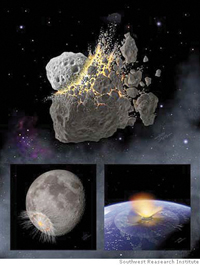 Baptistina asteroid
Baptistina asteroid
In 1980, famed Berkeley Lab physicist Luis Alvarez and his son, geologist Walter Alvarez, made headlines around the world when they reported evidence that an extraterrestrial object struck the earth some 65 million years ago, setting off an environmental cataclysm that drove the dinosaurs to extinction. The evidence was an exceptionally high concentration of iridium found in dozens of locations around the globe at the geologic boundary between the Cretaceous and Tertiary time periods. Iridium is a silver-gray metal, rare in the earth’s crust but abundant in meteorites and comets. The subsequent discovery of a huge impact crater called Chicxulub off the Yucatan Peninsula, plus shocked quartz and microtektites, have confirmed that the impact took place.
However, the object’s identity has remained a mystery. The Alvarez theory made headlines again this month when a team of scientists announced circumstantial evidence that the extraterrestrial dinosaur-killer was a massive fragment of rock, expelled when a huge asteroid named Baptistina was rammed by a smaller unnamed asteroid some 160 million years ago. This scientific team claims a 90 percent probability that a wandering fragment from Baptistina was the culprit behind the dinosaur extinction, but the extinction-theory expert Rich Muller, of the Physics Division, is not so sure. He believes a comet disrupted from the Oort Cloud by the gravity of a passing star is just as likely a suspect.
-- By Lynn Yarris
Sarah Laughed: Sonnets From Genesis
By Judith Goldhaber, with illustrations by Gerson Goldhaber; Ribbonweed Press; 170 pages; $14.95 (trade paperback)
Judith Goldhaber is a former science writer in Berkeley Lab’s Communications Department; her husband Gerson is a researcher in the Physics Division. Like their inspired 2005 collaboration, Sonnets from Aesop, Sarah Laughed unites Judith’s clever versifying with Gerson’s energetic paintings.

At first glance the tales sound familiar — the Garden of Eden, the Tower of Babel — but while Genesis is the inspiration, Sarah Laughed profits from centuries of folkloric and rabbinical accretions. The result is a work filled with wit and surprise, but free of pedantry or religiosity.
“Eve’s Rival,” for example, a cycle of nine sonnets narrated by Eve, tells the story of Lilith — not mentioned in Genesis but thought up later to explain why Genesis has two versions of the creation of man and woman. Thus Lilith was said to be Adam’s “first wife,” usually portrayed as a demon. But according to Eve
... She’s not as bad as she’s been painted — neither of us is likely to be sainted but we have lots in common, it appears ...
“The Ignorance of Cain,” by contrast, consists of a single, heartbreaking sonnet, which ends
I propped him up and called him by his name, blew in his ears and warmed him with my breath,
I never imagined such a thing as death.
“Noah and the Flood” features some (pardon the pun) antic departures from the Biblical text:
... craving his old diet of bugs, an aardvark hunted and pursued and ate a termite, though all meat was tabooed.
As you might guess, this almost caused a riot.
— leaving us to wonder why termites are still with us.
The wanderings of Abraham and Sarah, who “laughed when angels brought the news/that God would bless her ninety-year-old womb,” Jacob’s wily adventures, the saga of Joseph and his family — Judith’s poetry reminds us how quirkily human the ancient yarns of Genesis are.
The spirit is equally Gerson’s. Line drawings and splashes of watercolor combine as subtly as the diffuse shades of rose and lime in the introductory pages, or as raucously as the Tower of Babel, each level a different primary color, climbing to the sky. Humor and pathos mix on the page: Jacob weeps over Joseph’s bloodstained cloak, and its colors run together. Indeed, as Sarah guessed, “God must enjoy a joke.”
To order Sarah Laughed: Sonnets from Genesis, visit http://www.ribbonweedpress.com/.
People, Awards, and Honors
Governor Appoints EETD Expert to Biomonitoring Panel

Governor Schwarzenegger has appointed Thomas McKone to California’s Scientific Guidance Panel on Contaminant Biomonitoring. McKone is the acting head of the Indoor Environment Department in Berkeley Lab’s Environmental Energy Technologies Division. He is also an adjunct professor in UC Berkeley’s School of Public Health. The panel makes recommendations regarding the chemicals that are priorities for biomonitoring in the state, based on the likelihood of a chemical’s being a carcinogen or environmental toxin with potential exposure to the public.
Veteran LHS Educator to Head Lab’s Center
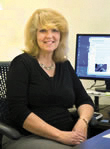
Susan Brady, who spent 15 years as a top administrator and educator at the Lawrence Hall of Science, has been chosen to succeed Rollie Otto as Head of Berkeley Lab’s Center for Science and Engineering Education. Brady was most recently Director of Education for the New York Academy of Sciences and spent five years after her LHS tenure as Director of Education Programs for the Merck Institute for Science Education. She has a B.S. in biological sciences from USC, and a Ph.D. in Botany from UC Berkeley. Otto retired last fall as CSEE’s first full-time director.
Bus, Truck Drivers Lauded for Safe Records
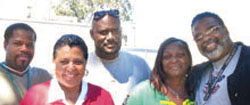
Lab bus and truck drivers who’ve gone consecutive years without a preventable accident on their records were honored for their achievement at a luncheon last week. Special recognition was given to those who’ve reached five-year milestones. Those honored for five years include Stephanie Martinez, Patrick Borden, Luster Howard and Robert Kelley. Ten-year recipients were Kathreen Bedford, Troy Foster, and Kevin Haugh. The program, now in its 52nd year, was created to promote safe driving at the Lab.
Six Lab Scientists Receive ACS Awards






The American Chemical Society has announced its 2008 National Award Winners, several of which are Berkeley Lab researchers. The scientists and their awards include (from left): Kenneth Raymond (Inorganic Chemistry), Don Tilley (Kipping Award in Silicon Chemistry), Gabor Somorjai (Priestley Medal), Frantisek Svec (Chromatography), Graham Fleming (Zewail Award in Ultrafast Science and Technology), and Daniel Neumark (Langmuir Award in Chemical Physics). Raymond, Tilley and Neumark are with the Lab’s Chemical Sciences Division. Somorjai and Svec are with the Materials Sciences Division. Deputy Director Graham Fleming is with the Physical Biosciences Division.
Young, Veteran Scientists Get Innovation Awards



Berkeley Lab materials scientists Rachel Segalman and J. Christopher Anderson, both 31, have been recognized by Technology Review Magazine as being among the world’s “Top Young Innovators” under the age of 35. Segalman was honored for discovering that cheap organic molecules can be used to generate electricity from heat, while Anderson was lauded for creating tumor-killing bacteria. Anderson, along with two other TR35 winners, worked in Berkeley Lab Physical Biosciences Division Director Jay Keasling’s lab. Also, Berkeley Lab Senior Scientist Alex Pines was selected as one of R&D Magazine’s top 100 innovators for his development in the area of magnetic resonance imaging that could eliminate the need for powerful magnets.
Health Sciences Grant for Two Lab Researchers


Berkeley Lab physical bioscientists Richard Mathies (left) and Evan Williams, along with other UC Berkeley researchers, are among those who have received a $4.7 million grant from the National Institute of Environmental Health Sciences to develop methods for detecting diseases in humans exposed to environmental contaminants. Williams is part of a team looking at protein adductomics, while Mathies serves on two teams, one researching lab-on-a-chip microsystems, and the other portable biosensors.
Life Scientist Gray on Advisory Board
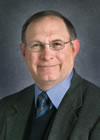
Joe Gray, associate Lab director and Life Sciences Division director, was recently selected to sit on the scientific advisory board of Cepheid, an on-demand molecular diagnostics company that develops, manufactures, and markets fully integrated systems for genetic analysis in the clinical, industrial and bio-threat markets.
In Memoriam
Sandi Fischer

Sandi Fischer, an administrative assistant in the Computational Research Division, died unexpectedly from natural causes at her home in Oakland on Sept. 9. She was 56. Fischer joined Berkeley Lab’s Environmental Health and Safety Division in 2000 and moved to the Computing Sciences organization in 2003. Most recently, she supported the Scientific Computing and Visualization groups. Her co-workers remember her kindness, helpfulness, diligence and efficiency. In her spare time, Fischer enjoyed her cats, reading, and relaxing at the beach. The family is not planning a funeral or memorial service, but memorial contributions may be made to charities supporting libraries, children, or animals.
Robert Mortimer

Robert Mortimer, a career Berkeley professor considered the father of the study of the yeast Saccharomyces ceerevisiae, passed away on Aug. 10. He started work in this field when asked by his UC Berkeley Ph.D. advisor Cornelius Tobias to prove that the number of chromosomes a cell had determined its resistance to radiation. Mortimer proved him wrong and spent the rest of his career working on yeast genetics. Mortimer was officially hired by Berkeley Lab as a faculty biophysicist in 1991 and retired in 1995, but served as a longtime guest prior to his hire and after his retirement.
Robert Riddell
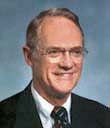
Robert James Riddell, Jr., a theoretical physicist at Berkeley Lab from 1955 until his retirement in 1982, died in Oakland on Aug. 16. He was 84. Riddell was hired as an instructor in the Physics Department at UC Berkeley in 1951 and moved to the “Rad Lab” — Berkeley Lab’s name at the time — four years later.